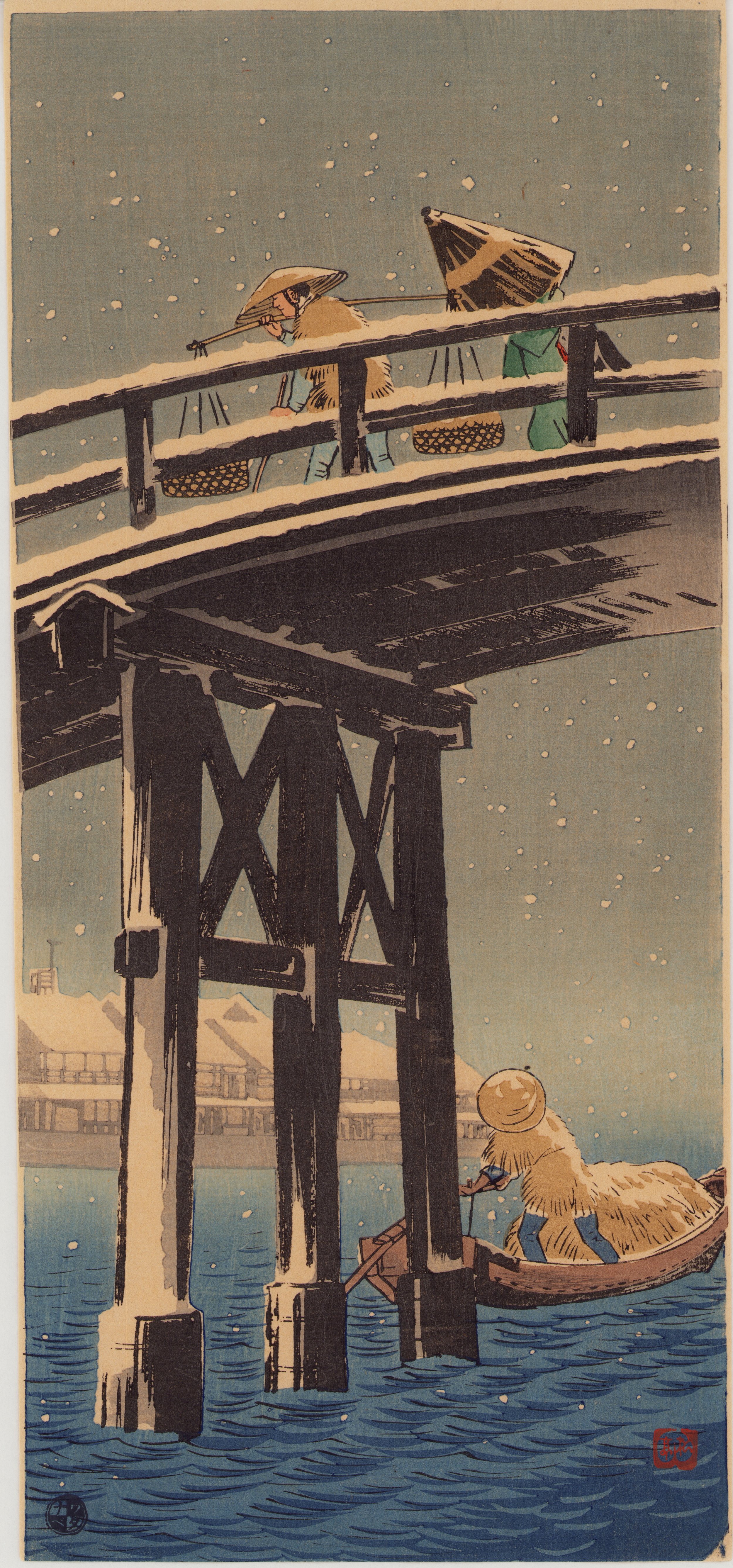Shotei | Shin Ohashi (Pre-Earthquake)
高橋松亭 Takahashi Shotei (1871–1945)
雪中新大桥
Shin Ohashi
1910s
木版画 | 大短册纵绘 | 36.8cm x 16.9cm
Woodblock-print | Nagaban Tate-e | 36.8cm x 16.9cm
地震前版本, 初版, 带渡边7mm的圆章;品相非常好
First edition from pre-earthquake, with 7mm Watanabe seal; great condition
SOLD
不同于广重《名所江户百景》中那幅著名的《大桥安宅夕立》,在松亭的笔下,雪中的新大桥又是另一番悠远静谧的景象。桥上,戴笠披蓑挑担归,美人伞半撑;桥下,艄公一身风雪摇着船桨,慢慢渡过隅田川。漆黑如墨刷的桥身画风格外硬朗,“版画味”十足,狭长的构图突出了主体,强化了画面由上至下的层次感,令人过目难忘,是松亭早期的杰作之一。
值得一提的是,本作左下角的圆章是渡边版最早使用的印章,即常说的“震前版”,存世量稀少,收藏价值极高。
Interested in purchasing?
Please contact us.
高橋松亭 Takahashi Shotei (1871–1945)
雪中新大桥
Shin Ohashi
1910s
木版画 | 大短册纵绘 | 36.8cm x 16.9cm
Woodblock-print | Nagaban Tate-e | 36.8cm x 16.9cm
地震前版本, 初版, 带渡边7mm的圆章;品相非常好
First edition from pre-earthquake, with 7mm Watanabe seal; great condition
SOLD
不同于广重《名所江户百景》中那幅著名的《大桥安宅夕立》,在松亭的笔下,雪中的新大桥又是另一番悠远静谧的景象。桥上,戴笠披蓑挑担归,美人伞半撑;桥下,艄公一身风雪摇着船桨,慢慢渡过隅田川。漆黑如墨刷的桥身画风格外硬朗,“版画味”十足,狭长的构图突出了主体,强化了画面由上至下的层次感,令人过目难忘,是松亭早期的杰作之一。
值得一提的是,本作左下角的圆章是渡边版最早使用的印章,即常说的“震前版”,存世量稀少,收藏价值极高。
Interested in purchasing?
Please contact us.
高橋松亭 Takahashi Shotei (1871–1945)
雪中新大桥
Shin Ohashi
1910s
木版画 | 大短册纵绘 | 36.8cm x 16.9cm
Woodblock-print | Nagaban Tate-e | 36.8cm x 16.9cm
地震前版本, 初版, 带渡边7mm的圆章;品相非常好
First edition from pre-earthquake, with 7mm Watanabe seal; great condition
SOLD
不同于广重《名所江户百景》中那幅著名的《大桥安宅夕立》,在松亭的笔下,雪中的新大桥又是另一番悠远静谧的景象。桥上,戴笠披蓑挑担归,美人伞半撑;桥下,艄公一身风雪摇着船桨,慢慢渡过隅田川。漆黑如墨刷的桥身画风格外硬朗,“版画味”十足,狭长的构图突出了主体,强化了画面由上至下的层次感,令人过目难忘,是松亭早期的杰作之一。
值得一提的是,本作左下角的圆章是渡边版最早使用的印章,即常说的“震前版”,存世量稀少,收藏价值极高。
Interested in purchasing?
Please contact us.
Takahashi Shotei (1871–1945)
Takahashi Shotei may have once been the most well-known Japanese woodblock print artist in the world, even if the Westerners who flooded Japan in the early part of the 20th Century didn’t know his name.
Watanabe Shozaburo hired him to design shinsaku-hanga (souvenir prints) to fulfill tourists’ demand for Ukiyoe-style woodblock landscape prints similar to those created in the past by masters of that genre, especially Hiroshige. These prints sold extremely well to this new audience, and were often in unusual sizes, to striking effect. (We wonder what Hiroshige would have thought of them.)
Shotei eventually took the name Hiroaki and produced hundreds of designs, but the blocks were destroyed in the Great Kanto earthquake of 1923. This is when Watanabe assigned him the unusual task of recreating his own works. He lived until 1945.


